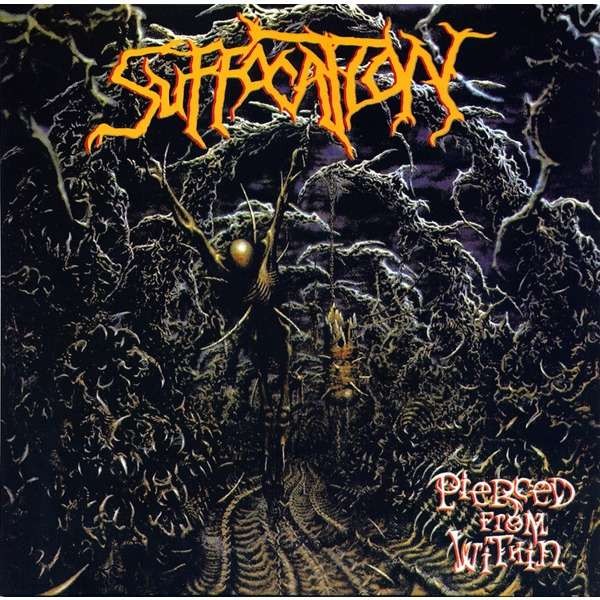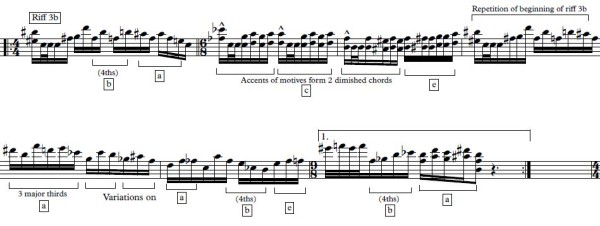
The title track of Suffocation’s third LP is a very interesting subject of analysis (as much as other excellent songs such as “Depths of Depravity”, “Suspended In Tribulation” or “Brood Of Hatred” from the same album could be) because it is a great example of recurrent motives reused in multiple different forms, of riff (musical ideas) progression and of narrative structure that ends with a climax and a release that brings a satisfying conclusion. The first step before going further is understanding how each idea of this song is crafted around the very simple and overused concept of two intervals a half step away from each other. The song is rather chromatic and has to be looked at with this idea in head.

In this case, as I will (try to) demonstrate, the most important interval is the major third, and then the perfect fifths/fourths. From this basis we can establish five constant elements that will be identified throughout the whole analysis.
- Element “a” is the collection of pitches that represent the major third intervals. Suffocation plays a lot with those intervals to create new motives and harmonies. It could also be considered as part of a harmonic minor scale (the last 3 degrees and the tonic).
- Same thing applies to element “b” but with the intervals of perfect fifths (and thus fourths), although the relation between the chromatic 5ths/4ths will gain another larger dimension sometimes.
- Element “c” is a diminished chord, something we will encounter frequently (Suffocation also uses frequently tritones and augmented fifth chords, especially in the Breeding The Spawn LP).
- Element “d” is a precise motive (and not collection) that finds meaning during the development of the song.
- Element “e” is just an ascending 3-notes chromatic scale that is used many times to partially conclude motives and phrases. It is of secondary importance.
I am not claiming that Suffocation used those leitmotifs very carefully and consciously like a classical composer would have, but my point is rather to show how, despite the lack of tonal material in the song “Pierced From Within”, unity was achieved between all components and how it creates a great song, structurally.
*From now on all the examples are in the F-clef*
Riff 1
The song starts with a long phrase at a fast tempo (riff 1) that is twice repeated. As shown in the score below, it is a mix of power chords and fast, technical strumming. We can see many manifestations of “a” as well as the repetition of rhythmic cells to create coherence. With its additional time, the last bar helps to generate an effect of oddness and temporal confusion through a more simple and effective way than modern bands trying over-technical rhythms and time signatures. This technique is used a few times in the song as you will see. Some have written the 3/4 as 12/8 but I prefer the former to adequately show rhythmic accents.
Riff 1 is followed by a short bridge made of an arpeggiated diminished chord (element c) and an augmented fifth chord (constructed upon two major thirds, suggesting “element a”).
Riff 2
From this long and complex riff, the music moves on to a generic “br00tal” verse (riff 2) where the vocals enter. However, it still manages to rhythmically catch interest due to the triplets at the end of the phrases.
Suffocation used different basic textures (tremolo, then muted power chords) to make both verses different while keeping the same harmonic outline, but this is not much of a big deal since the difference is not very flagrant:
Riff 3
Between the two verses appears riff 3(a), an intricate “melody” which marks a break for the vocals. This interlude introduces Suffocation’s technique of creating long musical phrases by the juxtaposition of motives that share different conclusions, yet constructed with the same material, as explained below. In addition of this, the different parts of the whole riff shift between “tonalities” or “regions”; where in the first bar the notes revolve around a certain fifth chord, in the next bar this fifth chord will be a semitone lower, hence the “larger” utilisation made of “element b” versus “a”. This is a very common (and cheap) way to make your material sound less repetitive when you are a bad and unoriginal death metal band, but in this song it becomes justified by the fact that the underlying concept of this technique is also used within a single part of a riff (and not only between parts) as the basis to craft multiple different melodic elements (just like the beginning of each bar in riff 3).
Right after our second verse, the song returns to the riff 3, but only for one bar because Suffocation shifts to a complete variation of it. While all the verses and riff 3a were written in 4/4, Suffocation adds another 4/4 bar after this first one (of riff 3b) and with the help of a drum fill switches to 6/8, once again destabilizing the listener. The ideas of riff 3a are then developed under groups of 6 sixteenth notes and constitute an even more intricate melody. Descending and ascending power chords bring us to an atonal cascade of notes which contains, of course, our previously identified elements rearranged in many ways. Mike Smith contributes to this by adding a lot of unexpected snare accents. Once again, Suffocation added a beat to the last bar to create the same effect as riff 1, but this time it is silent. This stop-start technique will be used a few times and is now an overused element of many technical bands. As usual, the whole riff is repeated with changes at the end to form a different and better transition.
Fun fact: the total of eighth notes comprised within the repetition marks of the riff is 47, a prime number, which proves the total irregularity of the “melody”.
Riff 3b, containing less literal repetition, brings us to what I called a “development”, because it is a short section of unique bars. Bar 1 and 4 are similar in concept, and the latter builds tension according to the former that will be released with another break and two violent snare hits. Between this, bar 2 and 3 offer chaotic rhythm where low palm muted chords meet high pitched tremolo notes and artificial harmonics. Notice that bar 1 uses what could be identified as harmonic minor scales, and thus suggesting our “element c” of diminished chords.
Riff 4
After this, riff 4 comes in as the powerful and savage release of the tension with its unmerciful tremolo phrases. You can see once again the technique of using different conclusions to the motive that starts each bar. On second repeat, the riff stays almost the same but emphasis is put on the phrases’ end with the removal of all instruments but one guitar to play the first beats of each bar, and with the addition of power chords on “conclusions”. The interesting element is right at the end of the riff: element d is heard very fast both times with both techniques. Then, again, the song stops and is followed by a slow, apocalyptic moment.
Breakdown and return
This moment is what I called (more or less rightfully) the “breakdown”. Now here is the trick: the first phrase of this section is exactly the same “element d” that concluded riff 4 but played way slower with power chords. Suffocation plays once again with textures and creates different accents with the use of palm mutes. And for another time, the last bar of the riff has an additional beat for your daily dose of rhythmic anarchy (or nihilism, as would say a controversial metal reviewer). This last bar present a rising chromatic phrase that we can interpret as developing “element d” and that presents a new 4-notes collection than in the first two bars. If you take those 2 pitches collections, you can notice that they are a major third away from each other (element a). I am not saying this was intentional or not, but I try to point out (coincidental?) links between all parts of the song.
The slow breakdown leads us to a sudden fast solo. I won’t analyze it here, but you can find a lot of “scales” constructed with “element a”. Listen also how the guitar sometimes melts with the triplets of riff 2.
The song returns to riff 3a, and then instead of continuing with riff 3b moves on to a new variation of the idea, riff 3c. This time, the riff takes a more urgent turn and creates the final tension, while Mullen cries the last lyrics: “I am your savior/Shapeless to your perception/For I am you/Pierced from within”. You can see how some melodic elements are now harmonized with major thirds. As usual, the second phrase (bars 3-4) uses a different conclusion.
After a repetition with a new ending, this rising tension is interrupted by a suspended chord that brings us to riff 1, played once. The song concludes abruptly before the end of the riff while the last words, “Pierced from within”, are repeated on the last four power chords. I did not talk much about vocals’ rhythm but it is cleverly constructed to fit the different parts of the song, and I am personally fond of how the lyrics are arranged in riff 3b.
Conclusions
As I said earlier, this approach might be over-technical and exaggerated, but the important thing for the reader is to at least understand how the song is well-crafted on every aspect and not entirely a sequence of random ideas. An analysis of a less technical song that contains great development would provide a good counterbalance to this article. Something out of Cianide’s The Dying Truth comes to my mind.
It is sad to think that after this album, Suffocation would never come up with anything on par with their previous material, because they certainly had to potential to improve and create new highly artistic pieces of aggressive and intelligent death metal. I still think their recent (post-reunion) albums are getting better each time and Pinnacle Of Bedlam, despite a terrible production, showed promising signs of great songwriting even though they apparently opted for a more tonal and melodic modern metal-like approach.
16 CommentsTags: analysis, death metal, Pierced From Within, suffocation











